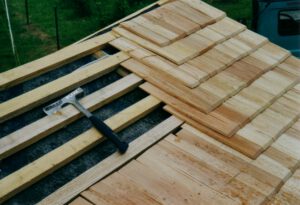Timber shingles have exceptional visual appeal and blend in harmoniously with the landscape. As a versatile construction material, timber shingles are used both in the traditional construction field, as well as in contemporary architecture.
 |
 |
Standard shingles in accordance with DIN 68119
The term standard shingles refers to sawn or split shingles, which have the same length but differing width. The base of the shingle is either straight or tapered at an angle of approx.
45 degrees (bevelled). These shingles can be wedge-shaped or have a constant width (See diagram below).
Split shingles |
Sawn shingles |
 Split shingle Split shinglewith a constant width (when length is more than 60 cm, this is a „laid shingle“) |
 Wedge-shaped Wedge-shapedsplit shingle („blade“ shingle) |
 Wedge-shaped Wedge-shapedsawn shingle (sawn shingle) |
Roof shingles
A roof covered with wood shingles has exceptional visual appeal. It is itself a piece of nature and blends harmoniously into the landscape with its soft ridge lines and contours and attractive silver-grey patina which develops as it ages. Wood shingles are a very versatile building material which enables any roof shape to be created. They have many possible uses not only in the traditional field, but also in contemporary architecture. Split shingles made from larch, red cedar, Alaska cedar and oak are used mainly for roofing purposes, as these woods contain substances which are particularly resistant to fungus or mechanical abrasion. Grade 1 sawn red cedar shingles are recognised as being a fire rated roof covering. The roof covering has at least three layers. This means that only approx. 1/3 of the shingle length is exposed to the weather.
Facades
Wood shingle cladding provides a reliable watertight and protective facade for any house. Depending on the type of shingle used, a shingle facade can last up to a hundred years without requiring any maintenance. Split or sawn shingles in a vast variety of shapes offer tremendous scope for design, allowing a facade to be created according to the local tradition, as well as the specific construction style and preference of the builder. Wood shingle cladding has a minimum of two layers. This means that only approx. ½ of the shingle length is actually exposed to the weather.
In terms of quality, roofs and facades made from wood shingles offer the following benefits:
- durable
- hail-proof
- frost resistant
- storm-proof
- light-weight
- heat insultating
- exceptionally environmentally-friendly
